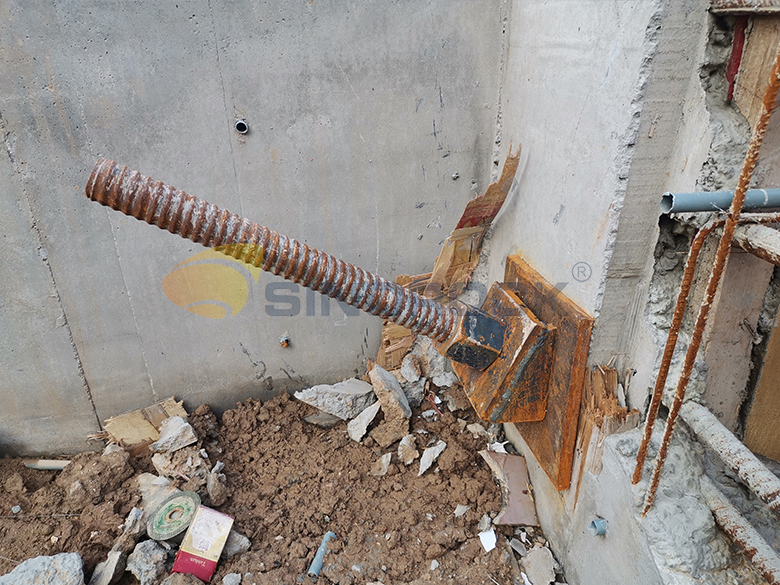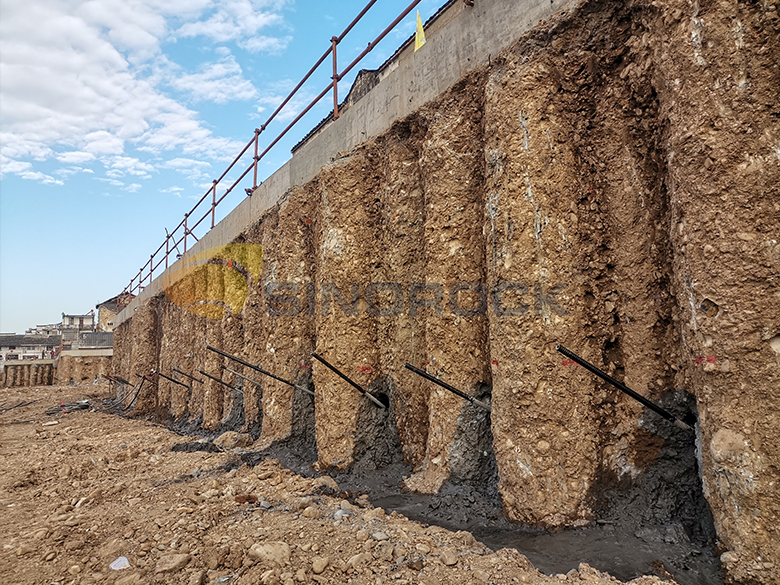Self drilling anchor bolts--An ideal solution for weak soil
Time:2024-03-27From:sinorock View:
I. Introduction
A. Overview of Weak Soil Challenges in Construction Projects
Construction projects often encounter challenges due to weak soil conditions. Weak soil, characterized by low bearing capacity, high compressibility, and poor drainage, poses significant risks to the stability and integrity of structures. Building on weak soil without proper reinforcement can lead to structural failures, settlements, and costly repairs.
B. Introduction to Self-Drilling Anchor Bolts as a Solution
Self-drilling anchor bolts emerge as a practical solution to address the complexities associated with weak soil. These anchoring systems integrate drilling, grouting, and anchoring functionalities into a single process, offering enhanced efficiency and effectiveness in stabilizing weak formations.
.png)
C. Purpose of the Article: Exploring the Effectiveness and Advantages of Self-Drilling Anchor Bolts in Addressing Weak Soil Issues
This article aims to delve into the realm of self-drilling anchor bolts, elucidating their significance, functionality, and advantages in mitigating the challenges posed by weak soil conditions. By comprehensively understanding the principles and applications of self-drilling anchor bolts, construction professionals can make informed decisions to ensure the success and durability of their projects.
II. Understanding Weak Soil
A. Definition and Characteristics of Weak Soil
Weak soil refers to soil formations with inadequate bearing capacity and stability, often characterized by high compressibility, low shear strength, and susceptibility to settlement. These soils include expansive clay, loose sand, peat, and organic deposits, among others.
B. Challenges Posed by Weak Soil in Construction
Construction on weak soil presents numerous challenges, including uneven settlement, foundation failure, structural damage, and compromised safety. Weak soil conditions necessitate specialized engineering solutions to ensure the stability and longevity of built structures.
C. Consequences of Building on Weak Soil Without Proper Reinforcement
Failure to address weak soil issues can result in dire consequences, such as structural deformations, cracks, and even collapse. Moreover, the need for costly remediation measures and retrofitting further underscores the importance of proactive soil stabilization strategies.
III. Introducing Self-Drilling Anchor Bolts
A. What are Self-Drilling Anchor Bolts?
Self-drilling anchor bolts, also known as hollow bar anchors or soil nails, are convenient anchoring systems designed to reinforce unstable soil and rock formations. These anchor bolts feature a hollow core, enabling simultaneous drilling and grouting during installation.

B. How do Self-Drilling Anchor Bolts Work?
Self-drilling anchor bolts penetrate the ground while simultaneously injecting grout to consolidate the surrounding soil or rock. This integrated approach ensures improved bonding and anchorage, enhancing the stability and load-bearing capacity of the ground.
C. Types and Variations of Self-Drilling Anchor Bolts Available in the Market
Self-drilling anchor bolts come in various configurations to suit diverse geological conditions and project requirements. Common variations include different thread profiles like R type and T type, lengths, and diameters, allowing for tailored solutions to specific applications.

D. Advantages of Self-Drilling Anchor Bolts over Traditional Anchoring Methods
Compared to traditional anchoring methods such as driven piles or drilled shafts, self-drilling anchor bolts offer several distinct advantages. These include reduced installation time, minimal disruption to surrounding structures, and enhanced adaptability to challenging ground conditions.
IV. The Application of Self-Drilling Anchor Bolts in Weak Soil
A. Pre-Construction Soil Assessment: Identifying Weak Soil Areas
Prior to construction, thorough soil assessment is essential to identify areas prone to weak soil conditions. Geotechnical investigations, including soil testing and analysis, enable engineers to delineate weak soil zones and devise appropriate stabilization measures.
B. Installation Process of Self-Drilling Anchor Bolts
The installation process of self-drilling anchor bolts is streamlined and efficient, comprising several sequential steps to ensure optimal performance in weak soil conditions:
1. Site Preparation
Before commencing installation, it is essential to clear the construction site and accurately mark the locations for anchor bolt installation. Clearing the site facilitates unobstructed access for equipment and personnel, ensuring smooth execution of subsequent installation steps.
2. Simultaneous Grouting while Drilling
One of the key advantages of self-drilling anchor bolts is their ability to perform simultaneous drilling and grouting, eliminating the need for pre-drilled holes. Utilizing the self-drilling feature, anchor bolts penetrate the soft ground with ease, facilitated by specialized drilling equipment. During drilling, a high-pressure pump is employed to inject grout through the hollow channel of the anchor rods. This process serves to fill fissures, voids, and irregularities in the surrounding rock and soil layers, effectively consolidating the ground and enhancing its load-bearing capacity.
3. Anchoring
The full-length threaded surface of the anchor rod plays a crucial role in enhancing the bond between the anchor rod and the injected grout or mortar. This ensures superior stability and anchorage, even in challenging soil conditions. In cases where additional length is required, anchor rods can be extended using couplers, providing flexibility to adapt to the specific requirements of each project.
4. Completion
The installation process is finalized with the installation of the plate and nut. Unlike traditional anchoring methods, where the drill rod may need to be pulled out after installation, self-drilling anchor bolts eliminate this step, preventing potential hole collapse and simplifying the overall installation process. The plate and nut are securely fastened to the protruding end of the anchor rod, providing a robust connection for subsequent structural elements or support systems.
By following these systematic installation procedures, construction professionals can ensure the effective deployment of self-drilling anchor bolts to stabilize weak soil conditions, enhancing the safety and longevity of construction projects.
V. Benefits of Self-Drilling Anchor Bolts
A. Increased Stability and Load-Bearing Capacity of Structures
By reinforcing weak soil, self-drilling anchor bolts enhance the stability and load-bearing capacity of structures, minimizing the risk of settlement and structural failure.
B. Time and Cost Efficiency Compared to Alternative Methods
The integrated drilling and grouting process of self-drilling anchor bolts significantly reduces installation time and labor costs compared to traditional anchoring methods, resulting in overall project savings.
C. Flexibility in Design and Adaptability to Various Soil Conditions
Self-drilling anchor bolts offer flexibility in design and installation, allowing engineers to customize solutions tailored to specific soil conditions and project requirements.
D. Environmental Sustainability Aspects of Using Self-Drilling Anchor Bolts
The use of self-drilling anchor bolts minimizes environmental impact by reducing the need for excavation, minimizing disturbance to natural habitats, and promoting efficient resource utilization.
VI. Conclusion
Weak soil poses significant challenges to construction projects, necessitating proactive soil stabilization measures to ensure the safety and longevity of built structures.
Self-drilling anchor bolts emerge as a reliable and efficient solution for stabilizing weak soil formations, offering increased stability, time and cost efficiency, and environmental sustainability benefits.
Sinorock encourages construction professionals to consider using our proud products——self-drilling anchor bolts as a solution for weak soil issues, leveraging their versatility, effectiveness, and proven performance in diverse construction scenarios. If have any questions or inquiries about self-drilling anchor bolts, please feel free to contact us at sinorock@sinorockco.com.
latest news
-

- What Are the Applications of SDA Bolts in Hydropower Stations?
- Time:2025-08-21From:This Site
- Learn how self-drilling anchor bolts enhance slope stability, tunnel support, and dam reinforcement in complex geological conditions at hydropower stations. Optimize hydropower projects with efficient, cost-effective, and eco-friendly solutions.
- View details
-

- Slope Stabilization with SDA Bolts: Benefits & Applications
- Time:2025-08-19From:This Site
- Discover how self-drilling anchor bolts (SDA bolts) provide superior slope stabilization for highways, railways, and tunnels. Learn their key benefits, installation process, and real-world applications in loose or collapsible soils.
- View details
-

- How Self-Drilling Rock Bolts Enhance Tunnel Support in Fractured Rock?
- Time:2025-08-15From:This Site
- Discover how self-drilling rock bolts enhance tunnel support in fractured rock. Learn their benefits, installation steps, and real-world applications for safe, efficient tunneling.
- View details
-

- Sinorock 2025 Quality Month | Strengthening Quality Foundations, Empowering Product Excellence
- Time:2025-08-13From:This Site
- Sinorock’s 2025 Quality Month, themed “Strengthening Quality Foundations, Empowering Product Excellence,” successfully concluded, reinforcing our commitment to superior product quality.
- View details
-

- Sinorock Safety Month 2025 | Everyone Speaks Safety, Everyone Can Respond
- Time:2025-07-03From:This Site
- Sinorock Safety Month 2025, centered on the theme "Everyone Speaks Safety, Everyone Can Respond - Spot Workplace Hazards," has wrapped up successfully!
- View details
-

- Quality Control: the Vital Factor of A SDA Bolt Factory
- Time:2025-01-09From:This Site
- Sinorock’s comprehensive quality control system, from supplier management to outgoing inspections, ensuring the highest standards for self-drilling anchor bolts in construction.
- View details
-

- Sinorock Invites You to Explore Proven Self-Drilling Anchor Bolt Solutions at bauma 2025
- Time:2025-03-07From:This Site
- From April 7–13, 2025, explore Sinorock’s Self-drilling anchor bolt solution at Booth C2.513/4 in Hall C2 of the Messe München Exhibition Center (Munich, Germany).
- View details
-
.jpg)
- SINOROCK to Attend EXPOMINA PERÚ 2024 in Lima, Peru
- Time:2024-08-10From:This Site
- Sinorock to Attend EXPOMINA PERÚ 2024 in Lima, Peru
- View details
-
.jpg)
- SINOROCK to Participate in MINING AND METALS CENTRAL ASIA 2024
- Time:2024-08-08From:This Site
- SINOROCK to Participate in MINING AND METALS CENTRAL ASIA 2024
- View details
 Download
Download 


